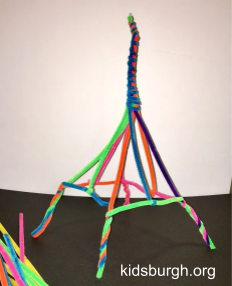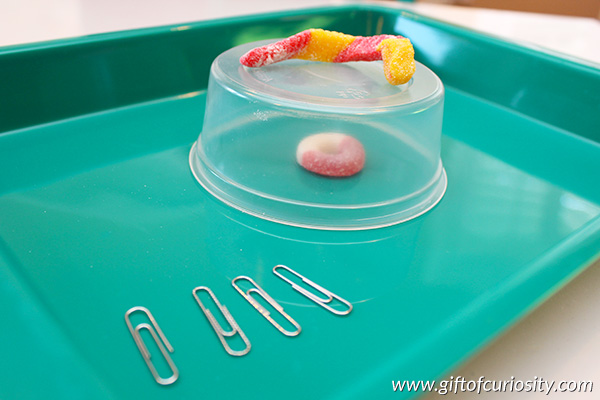Tired of cleaning up another experiment? Try a STEAM challenge to engage your child in new ways and watch their eyes light up with learning. These multi-disciplinary challenges, spanning Science, Technology, Engineering, Art, and Math, are the goldmine of creative and analytical thinking, as well as developing resilience, collaboration skills, and problem-solving.
STEAM activities follow familiar methodologies similar to the scientific method or design thinking. First, students understand the problem, brainstorm possibilities, design a solution, test it, then make improvements. Reflecting and making improvements to the original design is an often overlooked step that is the key to a successful STEAM lesson.
These types of challenges are considered inquiry-based teaching, a student-centered teaching methodology where the child’s question or problem guides the instruction. STEAM activities can be difficult to pull off in a large setting but can be eye-opening and inspiring experiences when managed properly in smaller groups. Check out our 6 tips for successful STEAM activities:
Pipecleaner Tower Challenge - Connect to real-world constraints with this intro challenge. Play the role of CEO and get out your camera out for some fun extras. Best in pairs, it could work solo.
- Connect to real-world constraints with this intro challenge. Play the role of CEO and get out your camera out for some fun extras. Best in pairs, it could work solo.
Supplies
As an engineer, you often need to work within a certain set of constraints to get the job done. What are constraints? Constraints are the limits or boundaries around a project, so it doesn’t take too long or cost too much.
Challenge
Allow 2 minutes to pass after approving their designs. As CEO, officially announce a pause in production, and introduce another constraint. Make up a story about how you are cutting back on extra help or have scaled globally and their partner speaks a new language. Have fun with it! Things I’ve tried:
Call time. Notice and note the characteristics of the different structures. Discuss them with each designer. Ask why it was built this way. Compare heights if applicable. Wrap up with a reflection on how it could have been built taller and stronger. It time permits, allow your students to try it again knowing what they know now.
Differentiation
Be flexible with time. If students are having difficulty with the planning stage, as the younger ones will, show some pictures or assist with the idea of a strong foundation, but resist the urge to help during the design phase.
Save Fred - This fun gummy challenge requires collaboration with a partner and creative thinking. Students of all ages - adults even - love this “snacktivity.”
- This fun gummy challenge requires collaboration with a partner and creative thinking. Students of all ages - adults even - love this “snacktivity.”
Supplies
As a special Navy SEAL operative, you are choppered in over [name of body of water] to save Fred. His boat has capsized with his life preserver underneath and Fred can’t swim! Can you save Fred by getting his body completely through the life preserver and safely into the boat?
Constraints
The lifesaver must be completely on Fred’s body, but watch out for constraint violations. Discuss exactly how they managed to save Fred. Challenge them to do it again in less time knowing what they know now.
Differentiation
There is little differentiation for this one. Some may finish in 2 minutes, some may need more than 5. Give them room to get frustrated. This is where the magic happens. Will they get frustrated and give up? Will they violate a constraint? Will they see what others are doing? Notice it all and call it out.
Figuring out the paper clips can be bent (not a constraint) allows small hands to use them like tongs to stretch the life preserver to squeeze Fred through. Let them figure it out on their own.
Take a brain break with a fun STEAM activity or use them as an incentive after a long week of learning. Connect it to the real world by creating your own stories. Your students are guaranteed to love it!
Creativity is thinking up new things. Innovation is doing new things.
- Theodore Levitt
- Theodore Levitt
STEAM activities follow familiar methodologies similar to the scientific method or design thinking. First, students understand the problem, brainstorm possibilities, design a solution, test it, then make improvements. Reflecting and making improvements to the original design is an often overlooked step that is the key to a successful STEAM lesson.
These types of challenges are considered inquiry-based teaching, a student-centered teaching methodology where the child’s question or problem guides the instruction. STEAM activities can be difficult to pull off in a large setting but can be eye-opening and inspiring experiences when managed properly in smaller groups. Check out our 6 tips for successful STEAM activities:
How do I deliver a successful STEAM Challenge?
- Keep it vague - The rules are intentionally up to interpretation. Give them room to tinker and figure out their own solutions within one or two constraints. If asked, repeat original rules.
- Resist the urge to help - Set the timer and allow their brain to light up with solutions.
- Time everything - Bonus if it is a timed competition between siblings
- Celebrate failure - Tower fell over? How could the foundation be stronger? Couldn’t finish? Great! I’ll give you 3 more minutes.
- Reflect - Prompt to articulate their thought process and how to improve. Write it down in a notebook. Don’t forget this part!
- Try again - Challenge to do it again - faster, better, taller.
Fun, Easy STEAM Challenges to Try
There are a ton of STEAM challenges out there to try, but have found incredible engagement with the following two specifically because of the story behind them. Facilitating with K-8, students of all ages love this tactile learning disguised as fun. Pipecleaner Tower Challenge
 - Connect to real-world constraints with this intro challenge. Play the role of CEO and get out your camera out for some fun extras. Best in pairs, it could work solo.
- Connect to real-world constraints with this intro challenge. Play the role of CEO and get out your camera out for some fun extras. Best in pairs, it could work solo. Supplies
- Pipe cleaners (X15, hidden from view)
As an engineer, you often need to work within a certain set of constraints to get the job done. What are constraints? Constraints are the limits or boundaries around a project, so it doesn’t take too long or cost too much.
You work for POWER Engineering Company with high tech materials to build the tallest skyscrapers in the world [show cool example]. Your two constraints are materials and time. You have 10 minutes to create the tallest, free-standing structure you can with an innovative new building material - pipecleaners. You have 2 minutes to plan. You will receive your building materials once your plan or sketch is approved by the CEO.
Challenge
Allow 2 minutes to pass after approving their designs. As CEO, officially announce a pause in production, and introduce another constraint. Make up a story about how you are cutting back on extra help or have scaled globally and their partner speaks a new language. Have fun with it! Things I’ve tried:
- One hand behind back
- Blindfolded
- Completely silent
Call time. Notice and note the characteristics of the different structures. Discuss them with each designer. Ask why it was built this way. Compare heights if applicable. Wrap up with a reflection on how it could have been built taller and stronger. It time permits, allow your students to try it again knowing what they know now.
Differentiation
Be flexible with time. If students are having difficulty with the planning stage, as the younger ones will, show some pictures or assist with the idea of a strong foundation, but resist the urge to help during the design phase.
Save Fred
 - This fun gummy challenge requires collaboration with a partner and creative thinking. Students of all ages - adults even - love this “snacktivity.”
- This fun gummy challenge requires collaboration with a partner and creative thinking. Students of all ages - adults even - love this “snacktivity.”Supplies
- 1 gummy worm (Fred)
- 1 gummy lifesaver candy (life preserver) – it must be the gummy kind, not the hard kind
- 1 small, clear plastic cup (boat)
- 4 paper clips (rescue materials)
As a special Navy SEAL operative, you are choppered in over [name of body of water] to save Fred. His boat has capsized with his life preserver underneath and Fred can’t swim! Can you save Fred by getting his body completely through the life preserver and safely into the boat?
Constraints
- You may only touch your rescue materials (paper clips), not Fred, the boat, or the life preserver directly with your hands.
- You must not let Fred fall into the lake (the table) or he’ll drown
- You must not injure (poke, puncture) Fred with your rescue materials
- You must not eat Fred.
- 5 minutes (flexible)
The lifesaver must be completely on Fred’s body, but watch out for constraint violations. Discuss exactly how they managed to save Fred. Challenge them to do it again in less time knowing what they know now.
Differentiation
There is little differentiation for this one. Some may finish in 2 minutes, some may need more than 5. Give them room to get frustrated. This is where the magic happens. Will they get frustrated and give up? Will they violate a constraint? Will they see what others are doing? Notice it all and call it out.
Figuring out the paper clips can be bent (not a constraint) allows small hands to use them like tongs to stretch the life preserver to squeeze Fred through. Let them figure it out on their own.
Take a brain break with a fun STEAM activity or use them as an incentive after a long week of learning. Connect it to the real world by creating your own stories. Your students are guaranteed to love it!





